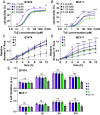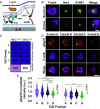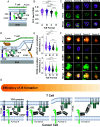Solution structure and synaptic analyses reveal determinants of bispecific T cell engager potency
- PMID: 40445758
- PMCID: PMC12146755
- DOI: 10.1073/pnas.2425781122
Solution structure and synaptic analyses reveal determinants of bispecific T cell engager potency
Abstract
Bispecific T cell engagers (TcEs) link T cell receptors to tumor-associated antigens on cancer cells, forming cytotoxic immunological synapses (IS). Close membrane-to-membrane contact (≤13 nm) has been proposed as a key mechanism of TcE function. To investigate this and identify potential additional mechanisms, we compared four immunoglobulin G1-based (IgG1) TcE Formats (A-D) targeting CD3ε and Her2, designed to create varying intermembrane distances (A < B < C < D). Small-angle X-ray scattering (SAXS) and modeling of the conformational states of isolated TcEs and TcE-antigen complexes predicted close contacts (≤13 nm) for Formats A and B and far contacts (≥18 nm) for Formats C and D. In supported lipid bilayer (SLB) model interfaces, Formats A and B recruited, whereas Formats C and D repelled, CD2-CD58 interactions. Formats A and B also excluded bulky Quantum dots more effectively. SAXS also revealed that TcE-antigen complexes formed by Formats A and C were less flexible than complexes formed by Formats B and D. Functional data with Her2-expressing tumor cells showed cytotoxicity, surface marker expression, and cytokine release following the order A > B = C > D. In a minimal system for IS formation on SLBs, TcE performance followed the trend A = B = C > D. Addition of close contact requiring CD58 costimulation revealed phospholipase C-γ activation matching cytotoxicity with A > B = C > D. Our findings suggest that when adhesion is equivalent, TcE potency is determined by two parameters: contact distance and flexibility. Both the close/far-contact formation axis and the low/high flexibility axis significantly impact TcE potency, explaining the similar potency of Format B (close contact/high flexibility) and C (far contact/low flexibility).
Keywords: breast cancer; immunological synapse; immunotherapy; multistate modeling; supported lipid bilayers.
Conflict of interest statement
Competing interests statement:F.L., F.S., M.C., S.R., H.N., D.W., S.H., S.C., D.Y., S.L., A.N., N.P., and S.K. work for Boehringer Ingelheim, which supported the research. S.J.D. is founder of MiroBio.
Figures





References
MeSH terms
Substances
Grants and funding
LinkOut - more resources
Full Text Sources
Research Materials
Miscellaneous

